sensor TOYOTA HIGHLANDER 2020 (in English) Owner's Guide
[x] Cancel search | Manufacturer: TOYOTA, Model Year: 2020, Model line: HIGHLANDER, Model: TOYOTA HIGHLANDER 2020Pages: 560, PDF Size: 14.42 MB
Page 250 of 560
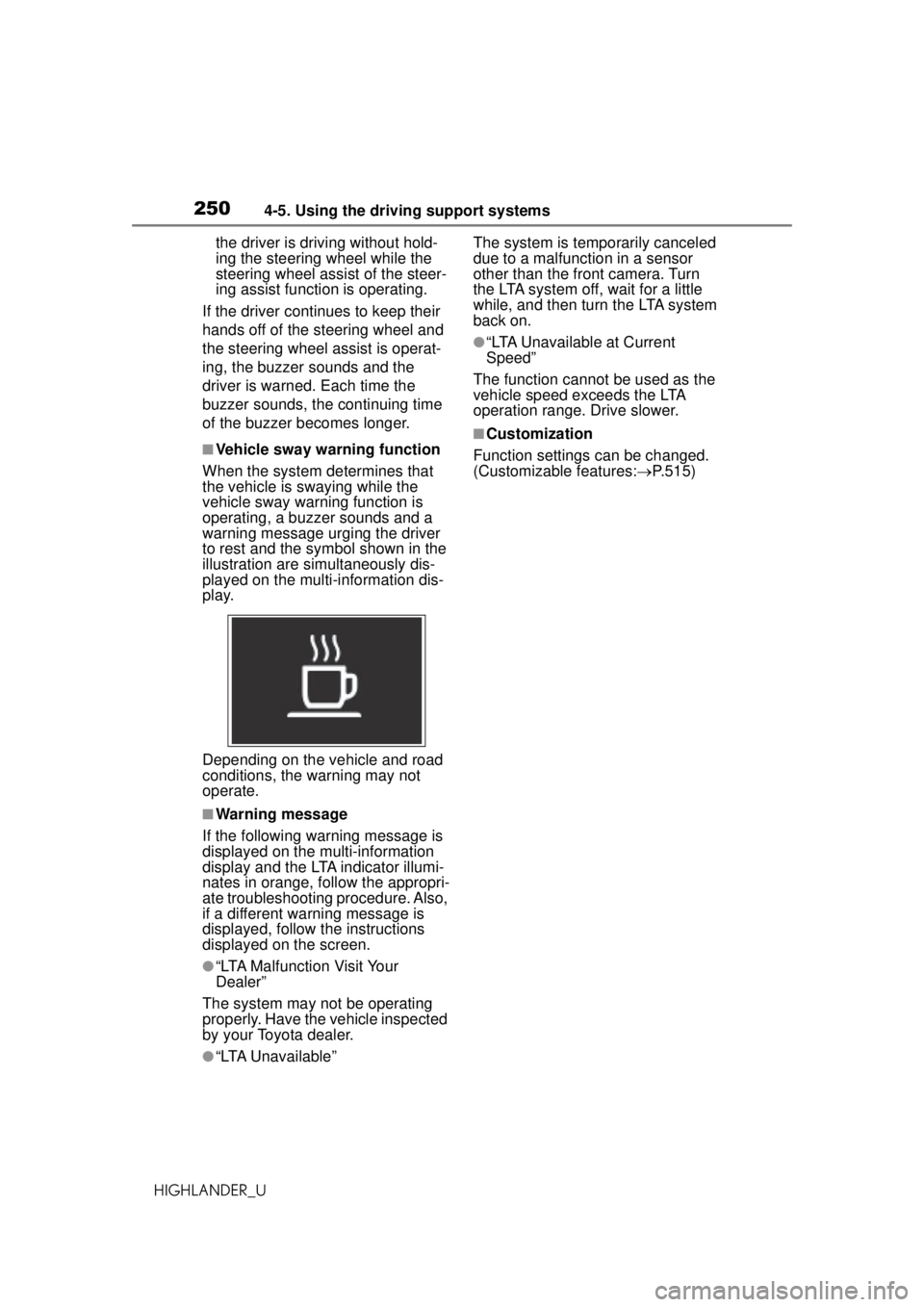
2504-5. Using the driving support systems
HIGHLANDER_Uthe driver is driving without hold-
ing the steering wheel while the
steering wheel assist of the steer-
ing assist function is operating.
If the driver continues to keep their
hands off of the steering wheel and
the steering wheel assist is operat-
ing, the buzzer sounds and the
driver is warned . Each time the
buzzer sounds, the continuing time
of the buzzer becomes longer.
Ō¢ĀVehicle sway warning function
When the system de termines that
the vehicle is swaying while the
vehicle sway warning function is
operating, a buzzer sounds and a
warning message urging the driver
to rest and the symbol shown in the
illustration are simultaneously dis-
played on the multi-information dis-
play.
Depending on the vehicle and road
conditions, the warning may not
operate.
Ō¢ĀWarning message
If the following wa rning message is
displayed on the multi-information
display and the LTA indicator illumi-
nates in orange, follow the appropri-
ate troubleshooting procedure. Also,
if a different warning message is
displayed, follow the instructions
displayed on the screen.
ŌŚÅŌĆ£LTA Malfunction Visit Your
DealerŌĆØ
The system may not be operating
properly. Have the vehicle inspected
by your Toyota dealer.
ŌŚÅŌĆ£LTA UnavailableŌĆØ The system is temporarily canceled
due to a malfunction in a sensor
other than the front camera. Turn
the LTA system off, wait for a little
while, and then turn the LTA system
back on.
ŌŚÅŌĆ£LTA Unavailable at Current
SpeedŌĆØ
The function cannot be used as the
vehicle speed exceeds the LTA
operation range. Drive slower.
Ō¢ĀCustomization
Function settings can be changed.
(Customizable features: ’é«P.515)
Page 253 of 560

2534-5. Using the driving support systems
HIGHLANDER_U
4
Driving
Ō¢ĀConditions in which the func-
tion may not operate or detect
correctly
In the following situations, RSA
does not operate normally and may
not recognize signs, display the
incorrect sign, etc. However, this
does not indicate a malfunction.
ŌŚÅThe front camera is misaligned
due to a strong impact being
applied to the sensor, etc.
ŌŚÅDirt, snow, stickers, etc. are on the
windshield near the front camera.
ŌŚÅIn inclement weather such as
heavy rain, fog, snow or sand
storms
ŌŚÅLight from an oncoming vehicle,
the sun, etc. enters the front cam-
era.
ŌŚÅThe sign is dirty, faded, tilted or
bent.
ŌŚÅThe contrast of electronic sign is
low.
ŌŚÅAll or part of the sign is hidden by
the leaves of a tree, a pole, etc.
ŌŚÅThe sign is only visible to the front
camera for a short amount of time.
ŌŚÅThe driving scene (turning, lane
change, etc.) is judged incorrectly.
ŌŚÅEven if it is a sign not appropriate
for the currently traveled lane,
such a sign exists directly after a
freeway branches, or in an adja-
cent lane just before merging.
ŌŚÅStickers are attached to the rear of
the preceding vehicle.
ŌŚÅA sign resembling a system com-
patible sign is recognized.
ŌŚÅSide road speed signs may be
detected and displayed (if posi-
tioned in sight of the front camera)
while the vehicle is traveling on
the main road.
ŌŚÅRoundabout exit road speed signs
may be detected and displayed (if
positioned in sight of the front
camera) while traveling on a
roundabout.
ŌŚÅThe front of the vehicle is raised or
lowered due to the carried load
ŌŚÅThe surrounding brightness is not
sufficient or changes suddenly.
ŌŚÅWhen a sign intended for trucks,
etc. is recognized.
ŌŚÅThe speed information displayed
on the meter and that displayed
on the navigation system may be
different due to the navigation sys-
tem using map data.
Ō¢ĀSpeed limit sign display
If the engine switch was last turned
off while a speed limit sign was dis-
played on the multi-information dis-
play, the same sign displays again
when the engine switch is turned to
ON.
Ō¢ĀIf ŌĆ£RSA Malfunction Visit Your
DealerŌĆØ is shown
The system may be malfunctioning.
Have the vehicle inspected by your
Toyota dealer.
Ō¢ĀCustomization
Some functions can be customized.
(Customizable features: ’é«P.515)
Page 254 of 560
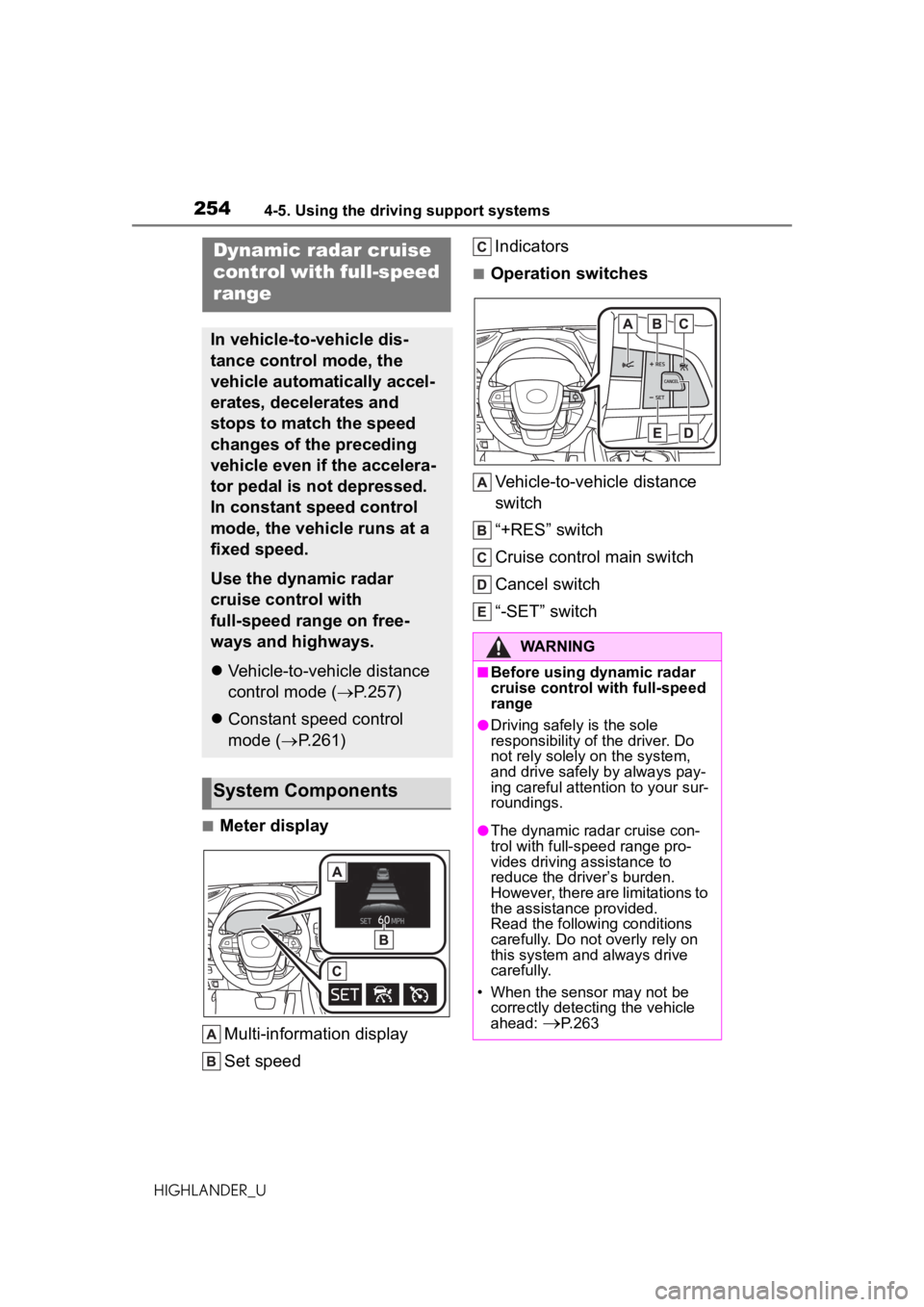
2544-5. Using the driving support systems
HIGHLANDER_U
Ō¢ĀMeter displayMulti-information display
Set speed Indicators
Ō¢ĀOperation switches
Vehicle-to-vehicle distance
switch
ŌĆ£+RESŌĆØ switch
Cruise control main switch
Cancel switch
ŌĆ£-SETŌĆØ switch
Dynamic radar cruise
control with full-speed
range
In vehicle-to-vehicle dis-
tance control mode, the
vehicle automatically accel-
erates, decelerates and
stops to match the speed
changes of the preceding
vehicle even if the accelera-
tor pedal is not depressed.
In constant speed control
mode, the vehicle runs at a
fixed speed.
Use the dynamic radar
cruise control with
full-speed range on free-
ways and highways.
’ü¼ Vehicle-to-vehicle distance
control mode ( ’é«P.257)
’ü¼ Constant speed control
mode ( ’é«P.261)
System Components
WARNING
Ō¢ĀBefore using dynamic radar
cruise control with full-speed
range
ŌŚÅDriving safely is the sole
responsibility of the driver. Do
not rely solely on the system,
and drive safely by always pay-
ing careful attent ion to your sur-
roundings.
ŌŚÅThe dynamic radar cruise con-
trol with full-speed range pro-
vides driving assistance to
reduce the driverŌĆÖs burden.
However, there ar e limitations to
the assistance provided.
Read the following conditions
carefully. Do not overly rely on
this system and always drive
carefully.
ŌĆó When the sensor may not be correctly detecting the vehicle
ahead:
’é«P. 2 6 3
Page 256 of 560
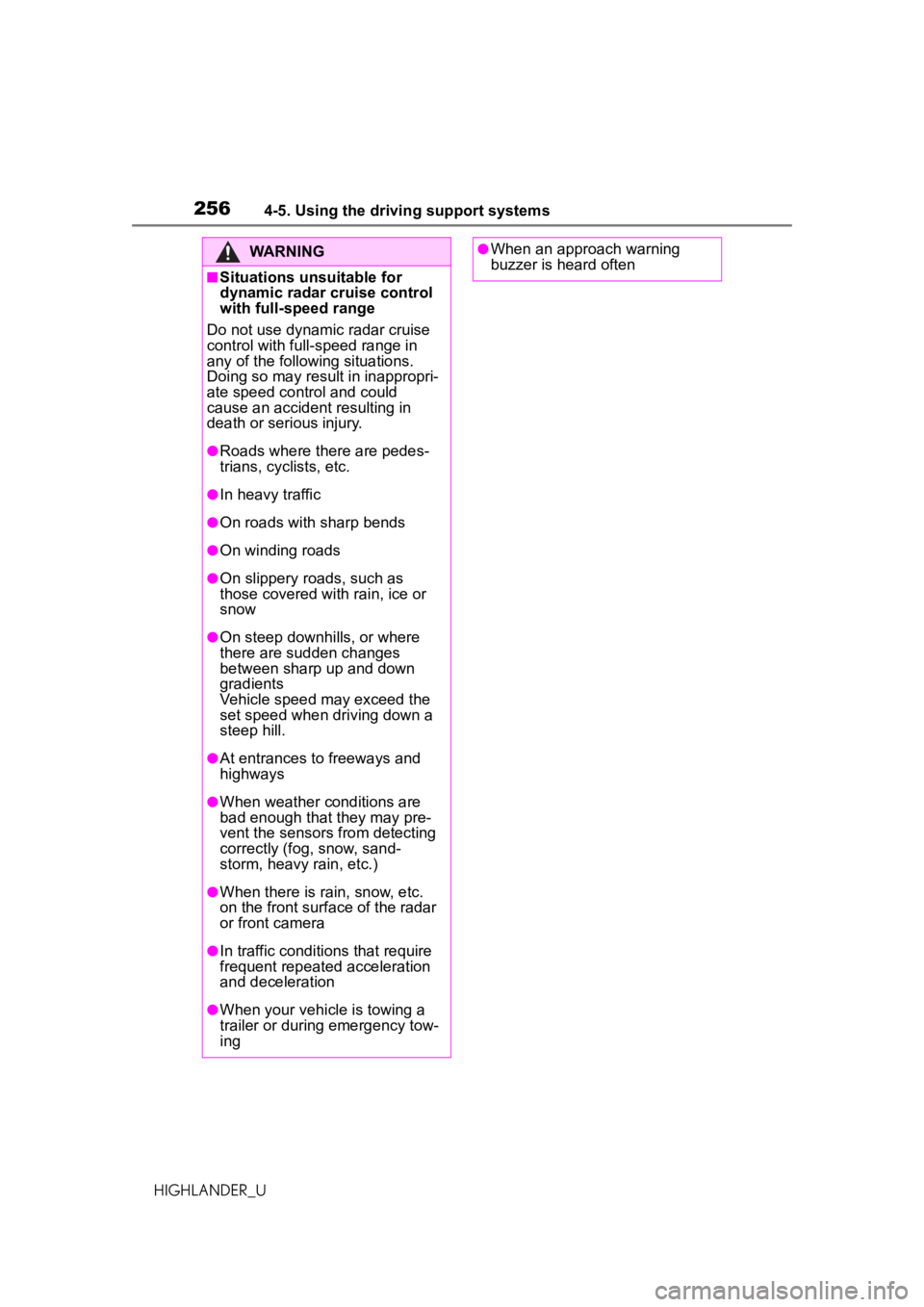
2564-5. Using the driving support systems
HIGHLANDER_U
WARNING
Ō¢ĀSituations unsuitable for
dynamic radar cruise control
with full-speed range
Do not use dynamic radar cruise
control with full-speed range in
any of the following situations.
Doing so may resu lt in inappropri-
ate speed control and could
cause an accident resulting in
death or serious injury.
ŌŚÅRoads where there are pedes-
trians, cyclists, etc.
ŌŚÅIn heavy traffic
ŌŚÅOn roads with sharp bends
ŌŚÅOn winding roads
ŌŚÅOn slippery roads, such as
those covered with rain, ice or
snow
ŌŚÅOn steep downhills, or where
there are sudden changes
between sharp up and down
gradients
Vehicle speed may exceed the
set speed when driving down a
steep hill.
ŌŚÅAt entrances to freeways and
highways
ŌŚÅWhen weather conditions are
bad enough that they may pre-
vent the sensors from detecting
correctly (fog, snow, sand-
storm, heavy rain, etc.)
ŌŚÅWhen there is rain, snow, etc.
on the front surface of the radar
or front camera
ŌŚÅIn traffic conditions that require
frequent repeated acceleration
and deceleration
ŌŚÅWhen your vehicle is towing a
trailer or during emergency tow-
ing
ŌŚÅWhen an approach warning
buzzer is heard often
Page 262 of 560
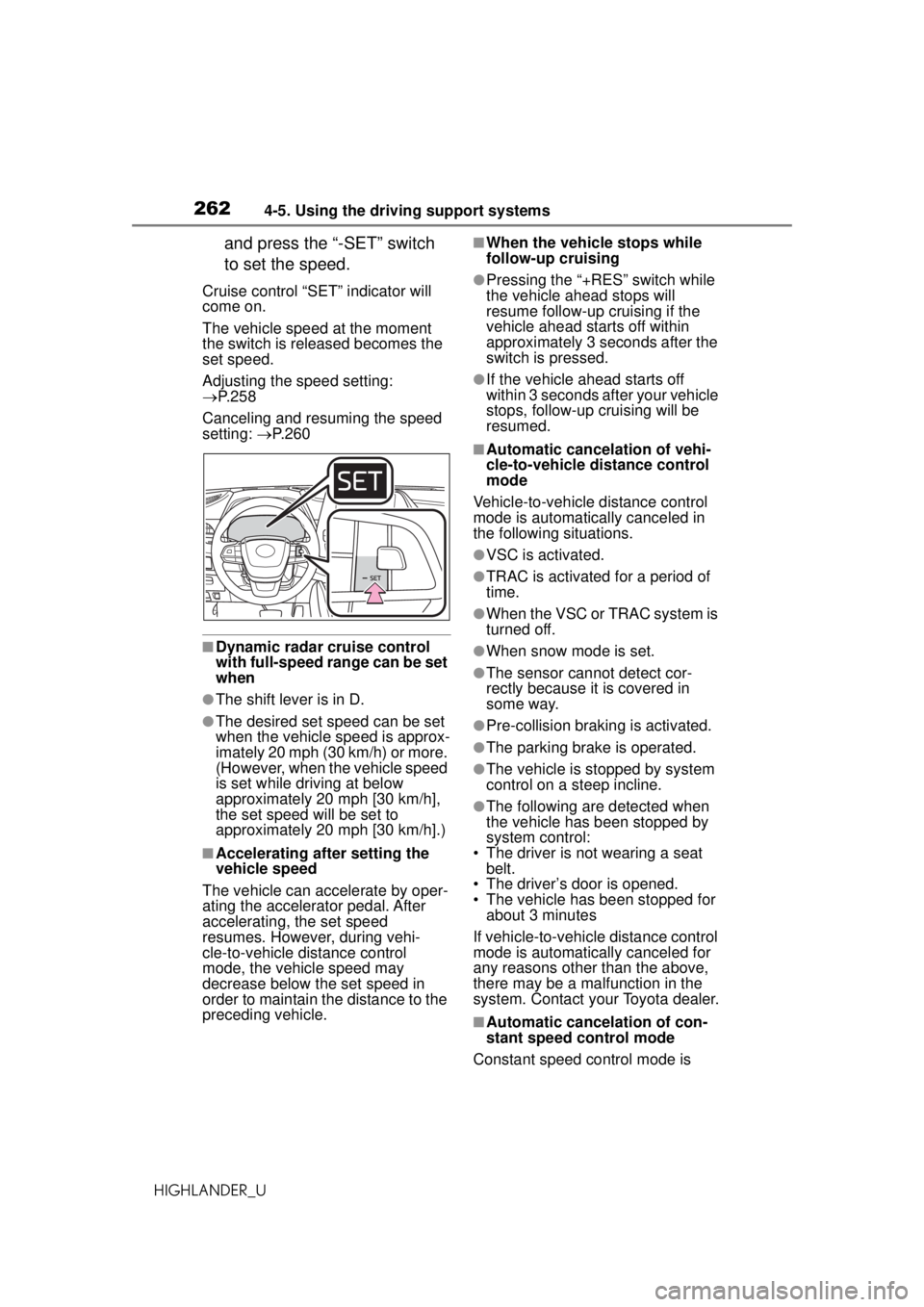
2624-5. Using the driving support systems
HIGHLANDER_U
and press the ŌĆ£-SETŌĆØ switch
to set the speed.
Cruise control ŌĆ£SETŌĆØ indicator will
come on.
The vehicle speed at the moment
the switch is released becomes the
set speed.
Adjusting the speed setting:
’é«P. 2 5 8
Canceling and resuming the speed
setting: ’é«P. 2 6 0
Ō¢ĀDynamic radar cruise control
with full-speed range can be set
when
ŌŚÅThe shift lever is in D.
ŌŚÅThe desired set speed can be set
when the vehicle speed is approx-
imately 20 mph (30 km/h) or more.
(However, when the vehicle speed
is set while driving at below
approximately 20 mph [30 km/h],
the set speed will be set to
approximately 20 mph [30 km/h].)
Ō¢ĀAccelerating after setting the
vehicle speed
The vehicle can accelerate by oper-
ating the accelerator pedal. After
accelerating, the set speed
resumes. However, during vehi-
cle-to-vehicle distance control
mode, the vehicle speed may
decrease below the set speed in
order to maintain th e distance to the
preceding vehicle.
Ō¢ĀWhen the vehicle stops while
follow-up cruising
ŌŚÅPressing the ŌĆ£+RESŌĆØ switch while
the vehicle ahead stops will
resume follow-up cruising if the
vehicle ahead starts off within
approximately 3 seconds after the
switch is pressed.
ŌŚÅIf the vehicle ahead starts off
within 3 seconds after your vehicle
stops, follow-up cruising will be
resumed.
Ō¢ĀAutomatic cancelation of vehi-
cle-to-vehicle distance control
mode
Vehicle-to-vehicle distance control
mode is automatically canceled in
the following situations.
ŌŚÅVSC is activated.
ŌŚÅTRAC is activated for a period of
time.
ŌŚÅWhen the VSC or TRAC system is
turned off.
ŌŚÅWhen snow mode is set.
ŌŚÅThe sensor cannot detect cor-
rectly because it is covered in
some way.
ŌŚÅPre-collision braking is activated.
ŌŚÅThe parking brake is operated.
ŌŚÅThe vehicle is stopped by system
control on a steep incline.
ŌŚÅThe following are detected when
the vehicle has been stopped by
system control:
ŌĆó The driver is not wearing a seat belt.
ŌĆó The driverŌĆÖs door is opened.
ŌĆó The vehicle has been stopped for
about 3 minutes
If vehicle-to-vehicle distance control
mode is automatically canceled for
any reasons other than the above,
there may be a malfunction in the
system. Contact your Toyota dealer.
Ō¢ĀAutomatic cancelation of con-
stant speed control mode
Constant speed control mode is
Page 263 of 560

2634-5. Using the driving support systems
HIGHLANDER_U
4
Driving
automatically canceled in the follow-
ing situations:
ŌŚÅActual vehicle speed is more than
approximately 10 mph (16 km/h)
below the set vehicle speed.
ŌŚÅActual vehicle speed falls below
approximately 20 mph (30 km/h).
ŌŚÅVSC is activated.
ŌŚÅTRAC is activated for a period of
time.
ŌŚÅWhen the VSC or TRAC system is
turned off.
ŌŚÅPre-collision brakin g is activated.
ŌŚÅThe parking brake is operated.
If constant speed control mode is
automatically canceled for any rea-
sons other than the above, there
may be a malfunction in the system.
Contact your Toyota dealer.
Ō¢ĀBrake operation
A brake operation sound may be
heard and the brake pedal response
may change, but these are not mal-
functions.
Ō¢ĀWarning messages and buzzers
for dynamic radar cruise con-
trol with full-speed range
Warning messages and buzzers are
used to indicate a system malfunc-
tion or to inform the driver of the
need for caution while driving. If a
warning message is shown on the
multi-information display, read the
message and follow the instruc-
tions.( ’é«P.231, 460)
Ō¢ĀWhen the sensor may not be
correctly detecting the vehicle
ahead
In the case of the following and
depending on the conditions, oper-
ate the brake pedal when decelera-
tion of the system is insufficient or
operate the accelerator pedal when
acceleration is required.
As the sensor may not be able to
correctly detect these types of vehi-
cles, the approach warning
( ’é« P.261) may not be activated.
ŌŚÅVehicles that cut in suddenly
ŌŚÅVehicles traveling at low speeds
ŌŚÅVehicles that are not moving in the
same lane
ŌŚÅVehicles with small rear ends
(trailers with no load on board,
etc.)
ŌŚÅMotorcycles traveling in the same
lane
ŌŚÅWhen water or snow thrown up by
the surrounding vehicles hinders
the detecting of the sensor
ŌŚÅWhen your vehicle is pointing
upwards (caused by a heavy load
in the luggage compartment, etc.)
ŌŚÅPreceding vehicle has an
extremely high ground clearance
Ō¢ĀConditions under which the
vehicle-to-vehicle distance con-
trol mode may not function cor-
rectly
In the case of the following condi-
tions, operate the brake pedal (or
Page 264 of 560

2644-5. Using the driving support systems
HIGHLANDER_Uaccelerator pedal, depending on the
situation) as necessary.
As the sensor may not be able to
correctly detect vehicles ahead, the
system may not operate properly.
ŌŚÅWhen the road curves or when the
lanes are narrow
ŌŚÅWhen steering wheel operation or
your position in the lane is unsta-
ble
ŌŚÅWhen the vehicle ahead of you
decelerates suddenly
ŌŚÅWhen driving on a road sur-
rounded by a structure, such as in
a tunnel or on a bridge
ŌŚÅWhile the vehicle speed is
decreasing to the set speed after
the vehicle accelerates by
depressing the accelerator pedal
*: If equipped
Ō¢ĀStopping the engine
While driving with the D shift
position selected, depress the
brake pedal and stop the vehi-
cle. The engine will stop auto-
matically.
When the engine stops, the Stop &
Start indicator will illuminate.
Ō¢ĀRestarting the engine
Release the brake pedal. The
engine will start automatically.
When the engine starts, the Stop &
Start indicator will turn off.
Stop & Star t system*
The Stop & Start system
stops and starts the engine
according to brake pedal or
shift lever operation when
the vehicle is stopped, such
as at a stoplight, intersec-
tion, etc., in order to
improve fuel economy and
reduce noise pollution
caused by the engine idling.
Stop & Start system oper-
ation
Page 270 of 560
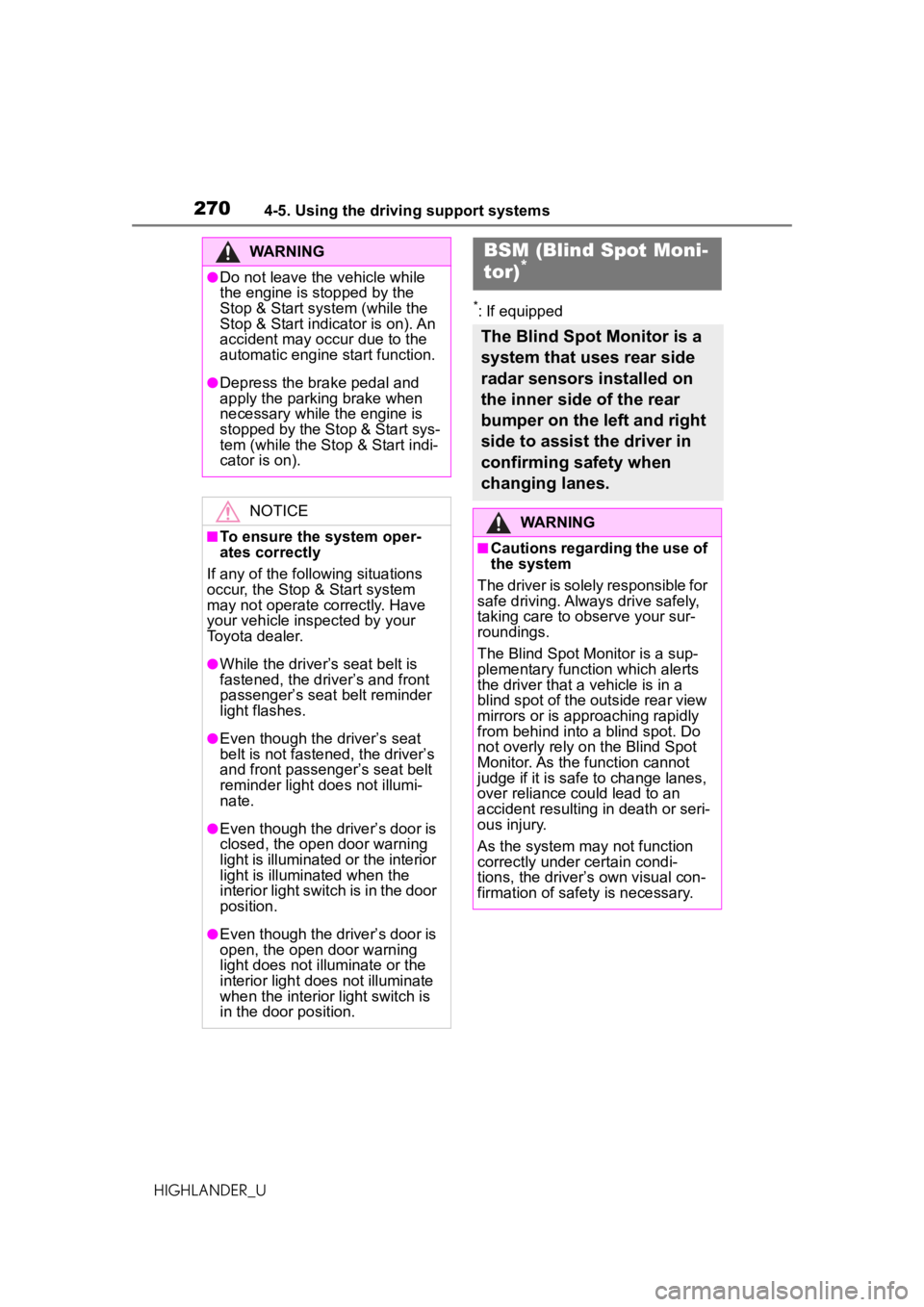
2704-5. Using the driving support systems
HIGHLANDER_U
*: If equipped
WARNING
ŌŚÅDo not leave the vehicle while
the engine is stopped by the
Stop & Start system (while the
Stop & Start indicator is on). An
accident may occur due to the
automatic engine start function.
ŌŚÅDepress the brake pedal and
apply the parking brake when
necessary while the engine is
stopped by the Stop & Start sys-
tem (while the Stop & Start indi-
cator is on).
NOTICE
Ō¢ĀTo ensure the system oper-
ates correctly
If any of the following situations
occur, the Stop & Start system
may not operate correctly. Have
your vehicle inspected by your
Toyota dealer.
ŌŚÅWhile the driverŌĆÖs seat belt is
fastened, the driverŌĆÖs and front
passengerŌĆÖs seat belt reminder
light flashes.
ŌŚÅEven though the driverŌĆÖs seat
belt is not fastened, the driverŌĆÖs
and front passengerŌĆÖs seat belt
reminder light does not illumi-
nate.
ŌŚÅEven though the driverŌĆÖs door is
closed, the open door warning
light is illuminated or the interior
light is illuminated when the
interior light switch is in the door
position.
ŌŚÅEven though the driverŌĆÖs door is
open, the open door warning
light does not illuminate or the
interior light does not illuminate
when the interior light switch is
in the door position.
BSM (Blind Spot Moni-
tor)*
The Blind Spot Monitor is a
system that uses rear side
radar sensors installed on
the inner side of the rear
bumper on the left and right
side to assist the driver in
confirming safety when
changing lanes.
WARNING
Ō¢ĀCautions regarding the use of
the system
The driver is solely responsible for
safe driving. Always drive safely,
taking care to observe your sur-
roundings.
The Blind Spot Monitor is a sup-
plementary function which alerts
the driver that a vehicle is in a
blind spot of the outside rear view
mirrors or is approaching rapidly
from behind into a blind spot. Do
not overly rely on the Blind Spot
Monitor. As the function cannot
judge if it is safe to change lanes,
over reliance could lead to an
accident resulting in death or seri-
ous injury.
As the system may not function
correctly under certain condi-
tions, the driverŌĆÖs own visual con-
firmation of safety is necessary.
Page 271 of 560
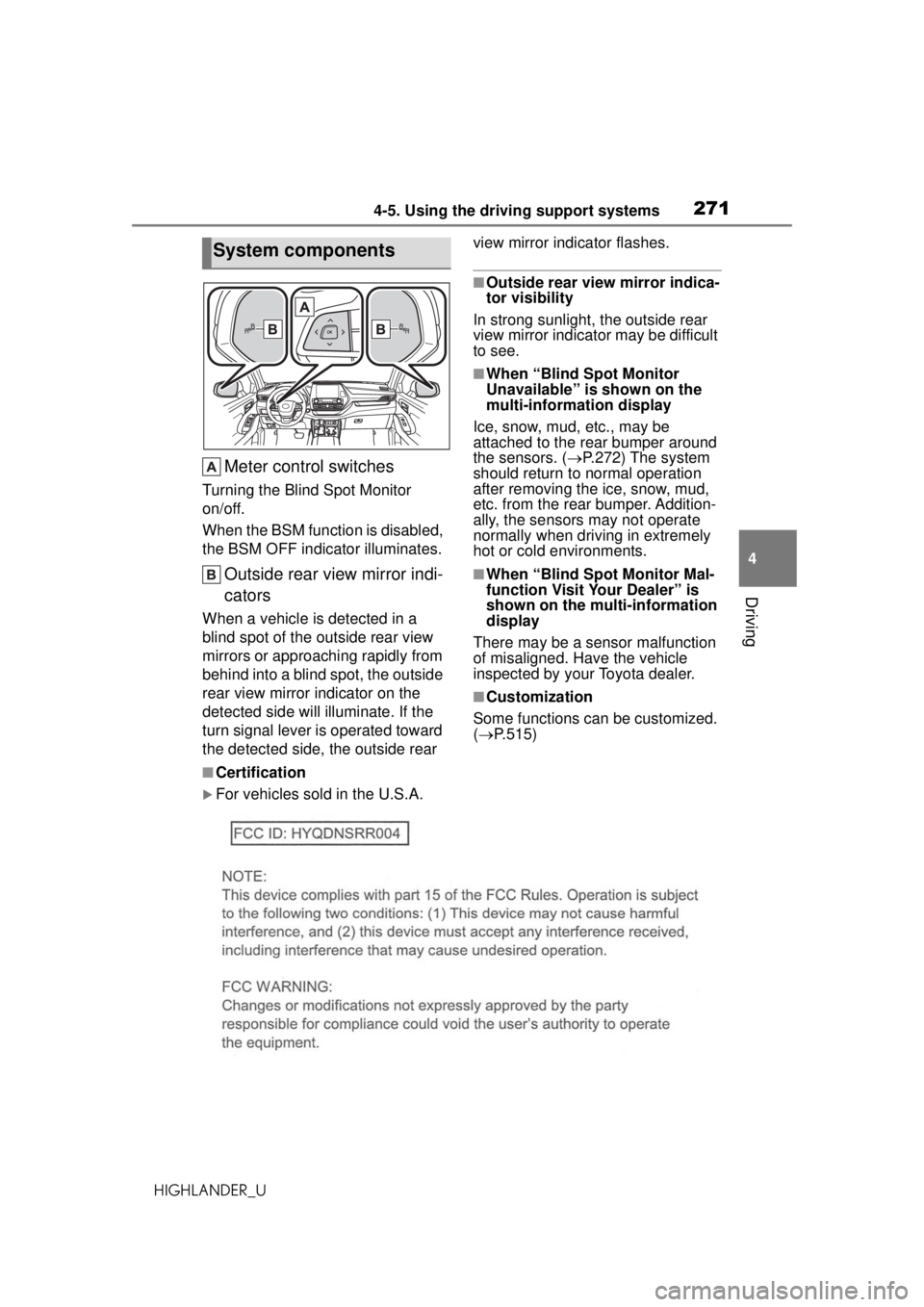
2714-5. Using the driving support systems
HIGHLANDER_U
4
Driving
Meter control switches
Turning the Blind Spot Monitor
on/off.
When the BSM function is disabled,
the BSM OFF indicator illuminates.
Outside rear view mirror indi-
cators
When a vehicle is detected in a
blind spot of the outside rear view
mirrors or approaching rapidly from
behind into a blind spot, the outside
rear view mirror indicator on the
detected side will illuminate. If the
turn signal lever is operated toward
the detected side, the outside rear view mirror indicator flashes.
Ō¢ĀOutside rear view mirror indica-
tor visibility
In strong sunlight, the outside rear
view mirror indicator may be difficult
to see.
Ō¢ĀWhen ŌĆ£Blind Spot Monitor
UnavailableŌĆØ is shown on the
multi-information display
Ice, snow, mud, etc., may be
attached to the rear bumper around
the sensors. ( ’é«P.272) The system
should return to normal operation
after removing the ice, snow, mud,
etc. from the rear bumper. Addition-
ally, the sensors may not operate
normally when driving in extremely
hot or cold environments.
Ō¢ĀWhen ŌĆ£Blind Spot Monitor Mal-
function Visit Your DealerŌĆØ is
shown on the multi-information
display
There may be a sensor malfunction
of misaligned. Have the vehicle
inspected by your Toyota dealer.
Ō¢ĀCustomization
Some functions can be customized.
( ’é« P.515)
Ō¢ĀCertification
’üĄFor vehicles sold in the U.S.A.
System components
Page 272 of 560

2724-5. Using the driving support systems
HIGHLANDER_U
’üĄFor vehicles sold in Canada
WARNING
Ō¢ĀHandling the rear side radar
sensor
Blind Spot Monitor sensors are
installed behind the left and right
sides of the rear bumper respec-
tively. Observe the following to
ensure the Blind Spot Monitor can
operate correctly.
ŌŚÅKeep the sensors and the sur-
rounding areas on the rear
bumper clean at all times.
If a sensor or its surrounding area
on the rear bumper is dirty or cov-
ered with snow, the Blind Spot
Monitor may not operate and a
warning message ( ’é«P.271) will
be displayed. In this situation,
clear off the dirt or snow and drive
the vehicle with the operation con-
ditions of the BSM function
( ’é« P.274) satisfied for approxi-
mately 10 minutes. If the warning
message does not disappear,
have the vehicle inspected by
your Toyota dealer.